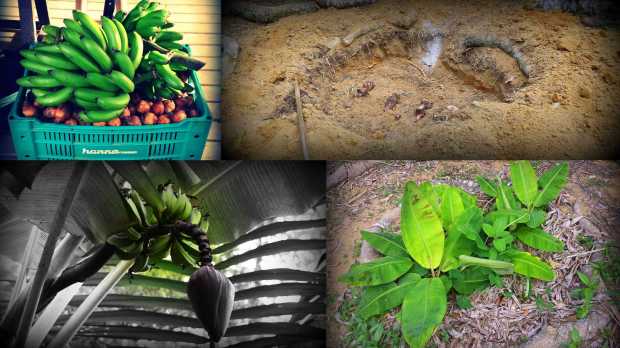We had a great amount of bananas growing throughout the mata (forest/jungle) of Capijuma. They grow all year around, though much slower during the cooler periods, and they were one of our steady local food supplies. They are not the long type that are widely available in Western supermarkets. The ones we had were much shorter, thinner, and sweeter.

(left top) a banana cluster we harvested; (left bottom) our bananas growing; (right top) we planted a few bananas in our agroforest; (right bottom) two months later the bananas were thriving in our agroforest
Of course having many bananas already doesn’t mean we can’t have more. And so we set out to plant more of them especially near the house. Around the same time we had switched to only using biodegradable cleaning products, which was really only coconut soap in bars for washing dishes & showers and in powder form for the washing machine. The latter is where we combined the two things.
We created our first banana circle in Capijuma not far from the washing machine so we could recycle the washing machine’s “waste” water (greywater). This ample supply will allow the water-loving bananas to thrive, hopefully bear big bunches of bananas, and in addition they will be cleaning the water, something they are quite good at. In addition the banana leafs create a humid climate around themselves, which is important to consider for companion planting. To create our banana circle we first dug a 1 meter deep hole with a diameter of 1 meter. The size can vary depending on the climate and how much water you would like to capture.

(left) at the top was our washing machine from where we put a pipe to our banana circle; (right) in the middle is the hole where the washing machine water goes into & around it are our bananas growing
Then we filled up the hole with big wood chunks, broken tiles, and big stones to create as many air pockets as possible to be filled by water. It’s best to use materials that won’t biodegrade or just slowly like wood. In the end we covered the hole with palm tree leaves to minimize evaporation and prevent things from falling inside.
Closely aligned around this hole (~20cm distance) we dug a few smaller more shallow holes (~50cm deep) where we planned the bananas (at a depth of ~25cm) and some other edible plants that like water and humidity.
To obtain banana seedlings we cut down banana plants and just used the lower part of it from which the roots and new seedlings will grow. The final part was for us to connected the pipe that carries the discarded washing machine water into the big hole, which will fill it up and provide the surrounding bananas with their very own water reservoir.

(left top) António digging with our lovely WWOOFers; (right top) banana circles dug out all around our pond to create a mandala; (left bottom) the banana circle water holes covered; (right bottom) just six weeks later most bananas have sprouted
As a symbol of our banana planting mania, our very last project we started in Capijuma was to create a big mandala of banana circles. We choose our octagonal pond as the epicenter with banana circles at each of its eight sides with over 30 bananas planned around them. Most of them sprouted within 6 weeks and in a little over a year they should have their first banana clusters growing.



I don’t know if it’s just me or if everybody else encountering issues with
your blog. It appears like some of the text within your content are running off
the screen. Can somebody else please comment and let me know if this is happening to them
as well? This may be a problem with my web browser
because I’ve had this happen previously. Thanks
LikeLike
The text is looking normal for me in Chrome & Safari.
LikeLike